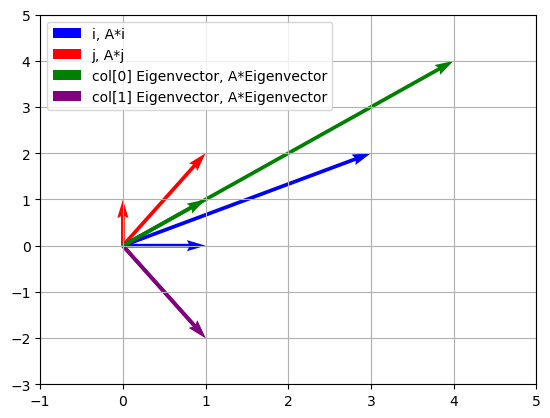Eingenvalues#
Let’s dive into eigenvalues, eigenvectors, and their significance in linear algebra, along with SageMath examples and visualizations.
Introduction
Definitions:
Think of a linear transformation (like stretching, rotating, or reflecting) applied to a vector space. An eigenvector is a special vector that, when the transformation is applied, only changes in magnitude (gets scaled), not direction. The scaling factor associated with that eigenvector is called its eigenvalue.
In simpler terms, eigenvectors are the “invariant directions” under a linear transformation. They point along the axes where the transformation’s effect is most straightforward – just stretching or shrinking.
Geometric Interpretation
Imagine a transformation that stretches a circle into an ellipse. The major and minor axes of the ellipse are the eigenvectors, and how much each axis stretches/shrinks represents the corresponding eigenvalue.
Computation
The process of finding eigenvalues and eigenvectors involves solving the following equation:
A * v = λ * v
where:
Ais a square matrix representing the linear transformationvis the eigenvectorλ(lambda) is the eigenvalue
This equation basically says: “When matrix A acts on vector v, it’s the same as simply scaling vector v by a factor of λ.”
SageMath Examples
Let’s use SageMath to find the eigenvalues and eigenvectors of a matrix:
A = matrix([[3, 1], [2, 2]])
print("Matrix A:\n", A)
eigenvalues, eigenvectors = A.eigenmatrix_right()
print("\nEigenvalues (on the diagonal):\n", eigenvalues)
print("\nEigenvectors (as columns):\n", eigenvectors)
Matrix A:
[3 1]
[2 2]
Eigenvalues (on the diagonal):
[4 0]
[0 1]
Eigenvectors (as columns):
[ 1 1]
[ 1 -2]
Eigenvalues on the Diagonal: The A.eigenmatrix_right() function in SageMath returns a matrix where the eigenvalues are located on the main diagonal. In this case, the diagonal elements are 4 and 1, representing the eigenvalues. Eigenvectors as Columns: The eigenvectors are returned as the columns of the matrix. So, the first eigenvector corresponding to the eigenvalue 4 is [1, 1], and the second eigenvector corresponding to the eigenvalue 1 is [1, -2].
Visualization with SageMath
We can visualize how the transformation defined by matrix A acts on the standard basis vectors and the eigenvectors:
import matplotlib.pyplot as plt
# Original basis vectors
i = vector([1, 0])
j = vector([0, 1])
# Transformed basis vectors
i_transformed = A * i
j_transformed = A * j
# Plot
plt.figure()
plt.quiver([0, 0], [0, 0], [i[0], i_transformed[0]], [i[1], i_transformed[1]],
angles='xy', scale_units='xy', scale=1, color='blue', label='i, A*i')
plt.quiver([0, 0], [0, 0], [j[0], j_transformed[0]], [j[1], j_transformed[1]],
angles='xy', scale_units='xy', scale=1, color='red', label='j, A*j')
colors = ['green', 'purple']
for i, v in enumerate(eigenvectors.columns()):
v_transformed = A * v
plt.quiver([0, 0], [0, 0], [v[0], v_transformed[0]], [v[1], v_transformed[1]],
angles='xy', scale_units='xy', scale=1, color=colors[i],
label=f'col[{i}] Eigenvector, A*Eigenvector')
plt.xlim(-1, 5)
plt.ylim(-3, 5)
plt.grid()
plt.legend(loc='upper left')
plt.show()

The blue and red quivers in the plot represent the original basis vectors (i and j) and their transformed versions after being multiplied by matrix A.
Let’s break it down:
Blue Quiver: This represents the standard basis vector
i = (1, 0). The blue arrow starts at the origin (0, 0) and ends at the point (1, 0). The transformed versionA * iis shown as a blue arrow starting at the origin and ending at the point whereiis mapped to by the transformation.Red Quiver: This represents the standard basis vector
j = (0, 1). The red arrow starts at the origin (0, 0) and ends at the point (0, 1). Similarly,A * jis shown as a red arrow starting at the origin and ending at the point wherejis mapped to by the transformation.
Why Show These?
Visualizing the original basis vectors and their transformed versions helps us understand how the linear transformation (represented by matrix A) distorts the space. It gives us a clear picture of how the transformation stretches, rotates, or reflects the standard coordinate axes.
Additional Notes:
The transformation defined by matrix
Ain your example seems to stretch theivector and slightly rotate bothiandj.The green (and purple, if you used the modified code) quivers represent the eigenvectors and their transformed versions, showcasing how they remain aligned with their original directions under the transformation.
Diagonalization and Applications
If a matrix has enough linearly independent eigenvectors, it can be diagonalized. This means we can express it in a simpler form:
A = P * D * P^(-1)
where:
Pis a matrix whose columns are the eigenvectorsDis a diagonal matrix with the eigenvalues on the diagonal
Diagonalization is immensely useful in:
Solving systems of differential equations
Calculating matrix powers efficiently
Simplifying calculations in quantum mechanics and other fields